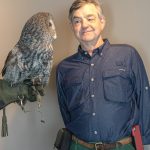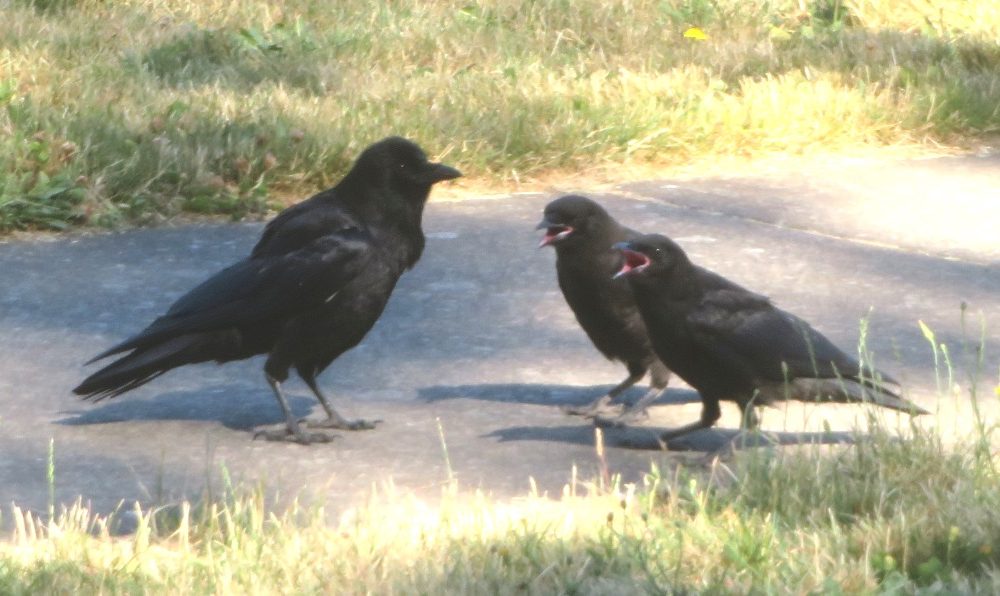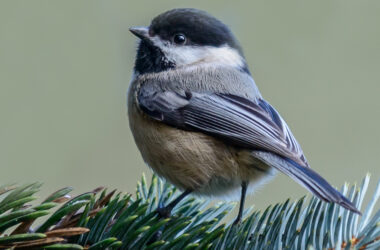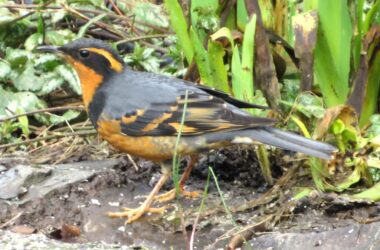This time of year bird families can be a familiar sight. Often both parents accompanied by young. In crow clans there may be a third caregiver.
The fledged young birds are learning the ways of the world. For days or even weeks, these newly arrived birds depend on their parents for food. Many are the lessons they need to learn: what to eat. Where to look. What to avoid. What various sounds and sights mean.
Birds that are crow-sized or smaller often eat prey whole. After birds leave the nest, that can often mean a parent will stuff a beak full of food into the open mouth of the begging youngster. It can be seeds, insects, a bit of fruit — whatever is on the menu.
The begging youngsters are often quite dramatic. They may plead with loud calls, never a musical sound. There can be wing fluttering as they are perched or on the ground. Tail feathers may be spread, the beak open while noise is added to the begging procedure. Often the adult bird will respond if there is food, ignore the performance if there isn’t food in its beak, or even yell back. I have seen young, hungry birds distract and distress a hunting adult bird. When the young have become strong fliers they may follow the adult, creating a ruckus.
Many young birds look like fluffy versions of the adults. Every ordinary crow is black unless it has unusual, white feathers (leucistic). A song is a dark, streaky bird —the young marked like the adult but not as adept or alert. In other species the young also look different. Juvenile robins, bluebirds and juncos have spots and streaks never seen on adult of the species. By winter all these smaller birds will have adult feathers.
This is not the case in large birds. Brown pelicans take three years to mature into adult plumage. Western and glaucous-winged gulls take four years. So do bald eagles. First year eaglets are mostly dark with various white paint splotches. Dark heads for sure. It takes four years to become the postage stamp eagle with pure white tail and white head. Some young birds are out of the nest while they still have pale downy feathers. Most young owls are speckled over white downy plumage. Young ducks and geese are often a mellow yellow when they begin swimming after a parent or two.
In some species the mother (or single father) does the parenting. In others — like Canada Geese— both parents are aggressively present and protective. But that’s another story.
For information about upcoming Salem Audubon programs and activities, see www.salemaudubon.org, or Salem Audubon’s Facebook page.
Harry Fuller is an Oregon birder and natural history author of “Freeway Birding” and the newly-published “Birding Harney County.” He is a member of the Salem Audubon Society. Contact him at [email protected] or atowhee.blog. His “Some Fascinating Things About Birds” column appears regularly in Salem Reporter.
SUPPORT OUR WORK – We depend on subscribers for resources to report on Salem with care and depth, fairness and accuracy. Subscribe today to get our daily newsletters and more. Click I want to subscribe!

Harry Fuller is an Oregon birder and natural history author of three books: “Freeway Birding,” "Great Gray Owls of California, Oregon and Washington," and "San Francisco's Natural History--Sand Dunes to Streetcars." He leads birding trips for the Malheur Field Station. He is a member of the Salem Audubon Society, and leads bird trips locally. Harry has just published a new book, BIrding Harney County.









